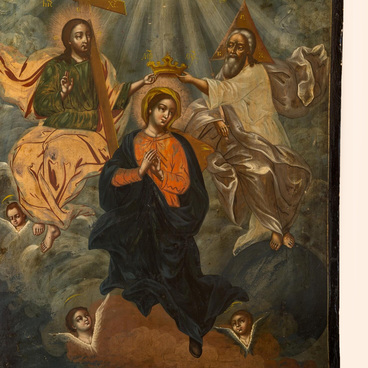Elijah is one of the most revered Old Testament prophets among Orthodox Christians in Russia. He zealously defended the faith in the true God and returned his people to Him. Elijah lived in the 9th century BC.
In the presented image, Elijah is depicted in several scenes. The central image of the prophet is the largest: Elijah is in the desert, and above his outstretched right hand, a raven descends, bringing him food. The prophet spent three years in solitude by the brook Chorath and was fed by ravens during the drought sent to punish Israel for worshiping Baal.
On the left side is the Old Testament plot of the miraculous acceptance of the sacrifice by the Lord through the prayer of Elijah: on the left are two pagan priests, opposite whom is Elijah addressing them, behind the figures is a flaming altar. In the third year of the drought, Elijah appeared to the wicked king Ahab, who popularized the pagan cult of Baal, and ordered him to gather all the people of Israel and the priests of Baal, so that the latter would make a sacrifice to Baal. He himself pledged to make the same sacrifice to the true God — on the condition that the people, convinced of the true God, would return to Him. The servants of Baal prayed for a long time with cries to their idol and even tortured themselves, but in vain. The Lord answered Elijah’s prayer and miraculously lit the fire, accepting the bull. The people were then convinced of Elijah’s rightness, and they executed the servants of Baal.
Below is the following plot of the biblical narrative about the prophet, when he, persecuted by Ahab for killing priests, retired to the desert. An angel appeared to the sleeping Elijah, fed him and informed him about his upcoming long journey (to Mount Horeb, where Elijah was to witness the appearance of the Lord).
The lower right corner of the icon depicts the episode of Elijah and Elisha’s miraculous crossing of the Jordan River:


